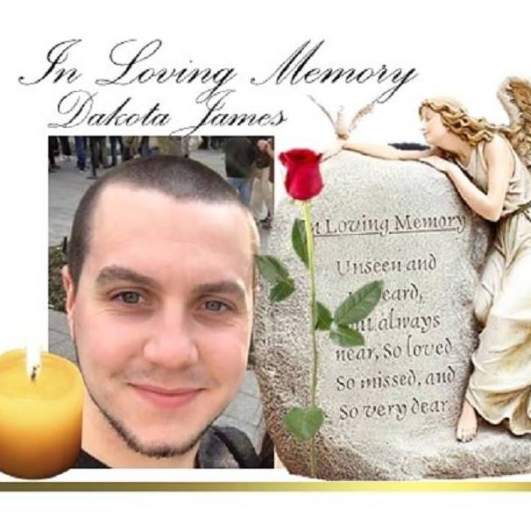
Facebook Dakota James
Dakota James was a 23-year-old Pennsylvania college student and aspiring lawyer whose body was found in the Ohio River after he disappeared while walking home to his apartment following a night out with friends.
His case is one of a string of drownings of young men throughout the United States that a group of former cops and a professor allege is part of a “smiley face” serial killer gang. The Oxygen channel is running a series about the theory called Smiley Face Killers: The Hunt For Justice. The death of Dakota James is one of six cases that are highlighted in the program.
To be sure, the smiley face serial killer theory is unproven, and law enforcement agencies in various jurisdictions have repudiated the claim that the drowning deaths are connected (or that at least some of them might be), assessing various deaths around the country as accidents and typically maintaining that alcohol – nights of heavy drinking – are the cause. However, since 1997, as the deaths accrued around the country – from New York to Wisconsin – retired New York Police Detective Kevin Gannon has spearheaded an investigation furthering the theory that a gang is killing young, athletic, academically gifted men, drowning them in rivers, and then leaving scrawled smiley faces at some of the scenes.
However, in the first show about the death of James, the investigators presented evidence from a well-known forensic pathologist that he might have been the victim of manual strangulation.
The show will premiere on January 19, 2019 at 7 pm. ET/PT. The other cases featured on the Oxygen channel show are the deaths of Tommy Booth, also in Pennsylvania; Lucas Homan in Wisconsin; Todd Geib in Michigan; William Hurley in Massachusetts; and Brian Welzien in Illinois.
Here’s what you need to know about the death of Dakota James:
1. Dakota James Was Last Seen Entering a Dark Alley

Dakota James
The death of Dakota James follows the pattern of many of these deaths. Age 23, he disappeared around 11:30 p.m. on January 25, 2017 in Pittsburgh, Pennsylvania.
“James was walking back to his apartment after a night out drinking with friends and co-workers. He never made it home. The last known sighting of the Duquesne University graduate student was caught on a surveillance camera in the downtown area,” reports Oxygen. “The footage captured James entering a dark alley, and that was the last time he was seen alive.”
The following morning, his family filed a missing person’s report when he didn’t show up for work. “James’ parents later hired a private investigator who organized a massive citywide search, which led to the discovery of James’ body in the Ohio River on March 6, 2017, 40 days after he had disappeared,” the channel reports. “The Pittsburgh police theorized James fell into the river while crossing a bridge near the city center and drowned. They believed his body traveled for almost 10 miles and even went through a dam before its discovery.”
However, claims Oxygen: “James’ body, however, had almost no visible damage, which was highly suspicious because it had traveled through heavily trafficked river. A smiley face was found spray painted on an underpass near where James’ body was discovered.”
2. The Drowning Deaths Occurred in ‘Clusters’ Around the Country
In a news release and email, the Oxygen Channel laid out the core of the smiley face serial killer theory.
“Since 1997, hundreds of college-aged men have mysteriously drowned, and their bodies have been found in clusters around the country, and the victims are eerily similar – they’re all athletic, academic achievers,” according to Oxygen.
“In addition, near where many of the bodies are recovered is one distinct mark: graffiti of a smiley face.T he series follows an active private investigation spearheaded by retired NYPD Detective Kevin Gannon and his veteran team of investigators as they work with victims’ families and top forensic experts to further investigate.”
Oxygen calls the drowning deaths the “country’s most notorious string of mysterious, accidental drownings” and alleges that they may not be accidents, “but homicides; and they could all be connected to a larger theory of The Smiley Face Killers.”
The men vanished after “a night out drinking with friends,” reports Oxygen. Along with Gannon, the investigators include Anthony Duarte, Mike ‘Mikey’ Donovan and D. Lee ‘Doc’ Gilbertson, “who have dedicated the past 12 years of their retirement to finding justice for these cases.”
Oxygen acknowledges that “all of the drownings have been individually classified as accidental or undetermined and have not been investigated as possibly related crimes. There are grieving families of these young men who are convinced that there is something more sinister at play, and desperately search for answers with Gannon and the team. Their goal is to gather enough evidence to convince local authorities to reclassify and investigate these deaths as homicides. Only then can the team attempt to establish a possible connection between these deaths to further their theory that the young men are victims of a calculated group known as The Smiley Face Killers.”
A 2008 article in Milwaukee Magazine dug deeper into the theory. At that time, Gannon and his team had launched a media blitz to gain currency for the theory after deaths occurred in Wisconsin and Minnesota, gathering heavy news coverage in those states.
Reported Milwaukee Magazine: “After three months of research into the case, Milwaukee Magazine has learned a gang …claims involvement in the deaths of some of these men. Convicted murderer Jeramy Alford, who is also a suspect in a river death that police now believe is a homicide” spoke to authorities about the accusations. Although local cops said they’d run across that gang before, no charges have ever been brought against Alford or members of that group in association with any of the river deaths. Authorities have never alleged any connection between the group and the smiley face deaths. (Alford has been in prison since 2006 and, thus, could not have committed various alleged smiley face murders, including that of James.)
“In a letter obtained by Milwaukee Magazine, the FBI said there’s no evidence the gang exists, but admits Alford discussed the gang,” the article reported.
That article dealt heavily with the death of Chris Jenkins, a Burlington, Wisconsin man who was found in the Mississippi River after a night out drinking in Minneapolis.
As far back as 2002, The New York Times was reporting: “Young People Are Missing; Authorities Are Baffled.” That article reported that Jenkins was one of four young men who drowned in rivers in Minnesota and Wisconsin. The article described Jenkins as “a senior and co-captain and goalie of the lacrosse team at the University of Minnesota. Dressed as an American Indian, he had gone to a Halloween party at the Lone Tree Bar and Grill.” For years, police in the Jenkins’ case would not say that Jenkins died from foul play. However, in 2006, they did a shocking about-face.
In 2006, The Associated Press reported that police announced Jenkins “was thrown off a bridge in downtown Minneapolis …they apologized for first suspecting his death was a suicide or accident.” The cause of death had initially been listed as undetermined. However, although they had a suspect in mind at the time, no one was ever charged. “Chris’ death at this time is not linked to any of these other deaths, especially there’s quite a few involving college students,” Sgt. Pete Jackson told the AP at that time. “I have been contacted today quite a bit by other agencies from around the Midwest. We’ve had several deaths involving college students. But there’s nothing at this time to connect Chris’ death between the others.”
However, authorities’ reclassification of the Jenkins’ death as a homicide has helped fuel the serial killer theory.
According to The New York Post, Gannon first became suspicious, though, after the death of a young man in 1997. Patrick McNeill left a New York City bar and his body was found floating by a Brooklyn pier.
Gilbertson, who is an expert in spatial analysis, found patterns in river deaths throughout the country, including the fact that, at that time, “94 percent of the deaths occurred within 100 miles of Interstate 94. The men are generally fit, good-looking, Caucasian, in their 20s, and separated from friends after nights in bars or parties. A few vanished after leaving dorms. Most are drunk. Most turn up dead in rivers or lakes, and with no obvious trauma.” The team told the news media back then that they had found 22 smiley faces.
“The smiley faces are rudimentary, mostly drawn in white paint. Some have three-pointed crowns. Nine have horns. A red smiley face was reportedly found in a drainage ditch in the March 2007 death of Abel Bolanos, 19, a college student found in an Iowa lake. It reads: ‘Evil Happy Smiley Face Man.’ The detectives claim they have 12 pieces of matching evidence, including nicknames left at scenes,” the magazine reported.
3. An Independent Examination of the Dakota James’ Autopsy Photos Has Challenged Authorities’ Findings

Dakota James
The family of Dakota James is also not buying the official line that their son died accidentally.
According to the Pittsburgh Post-Gazette, the independent autopsy in the Dakota James’ case found that James “may have been strangled and did not die accidentally as law enforcement contends.” The new claim was revealed in mid December 2018 at a news conference. Authorities had ruled his death an accident.
“Today we are here to say that our son, Dakota, did not get drunk, cross four lanes of a highway, a cement barrier, walk down approximately 30 steps to urinate, to then accidentally fall in the river,” James’ mother, Pam James, said at the news conference, the newspaper reported. “To us this is a homicide, and we will continue to look for the answers on why and by whom.”
At their side at the news conference: Gannon and the prominent forensic pathologist Dr. Cyril Wecht, who said at the press conference that he noticed ligature marks in the autopsy photos. “There is no question about there being markings,” Dr. Wecht said, according to The Post-Gazette. “We would describe these as furrows that would be consistent with some kind of a ligature – we cannot tell you exactly what – but the markings are there, they are clearly discernible…”
On the Oxygen show, Wecht said that the marks on James’ neck “strongly suggestive of and entirely consistent with a ligature having been applied around the neck. This death may have been due to ligature strangulation.”
4. Dakota James Was a College Student & Authorities Have Contested the New Findings

Dakota James
At the time of his death, James was a college student at Duquesne University.
Amie Downs, communication official, responded on behalf of the medical examiner’s office and told TribLive of the autopsy claims that no new evidence had been offered to the office “including any physical evidence that the James’ family has indicated they have.”
A spokesperson for the Allegheny County District Attorney Stephen A. Zappala told TribLive: “It has become clear to us that based on the evidence in the original file and the conversations with Pam (James’ mother), there is nothing more that our office can do at this point to assist her, and that has been communicated to her.”
There is a Facebook page devoted to Dakota James’ memory. It hasn’t been updated since 2017, though, when his body was found, and it was initially created when he was still missing. Before he was found, the page said, “Circumstances: Dakota went missing after happy hour drinks with co workers. He’s not had any cell phone activity and hasn’t shown up to work. His family is extremely worried and ask if you have any info, or see him.”
5. James’ Family Has Started a Foundation in His Memory

Dakota James
James’ parents have started a foundation in his memory called The Dakota James Foundation. The website says:
Our son, Dakota James, 23 went missing in Pittsburgh, PA on Wednesday, January 25, 2017 and his body was found in the Ohio River on Monday, March 6, 2017. He worked full-time, lived on his own, and was attending college full-time to earn his master’s degree in a city he loved. He was very active in swimming, running, biking, and loved music and dancing. He enjoyed life to the fullest and trusted everyone. His future plans included attending law school, traveling, getting married, and starting a family.
Never in our wildest dreams did we ever think we would get the call to say your son is missing. We struggled on a daily basis trying to find answers-running into red tape and contradicting policies of local agencies and unresponsive authority figures. We did not know where to turn for help.
We want to make changes so that this doesn’t happen to the next family of a missing person.
The foundation says its mission is to encourage “collaboration to ensure public safety through improved surveillance, police procedures and cooperation, raising awareness and supporting families of a missing person.”
